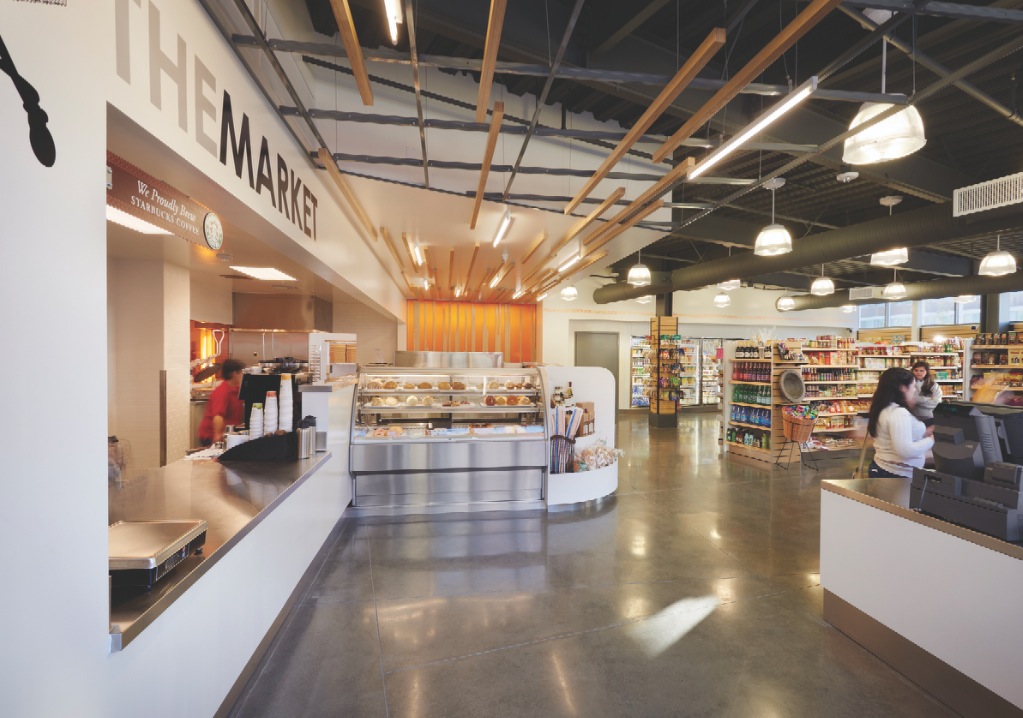One of the biggest trends for American Campus Communities, a leading student-housing development and property management real estate investment trust, has been “the amount of academic space we’re putting into our common amenities” in the last two development cycles. That’s what Bill Bayless, ACC’s CEO, told the National Association of Real Estate Investment Trusts’ annual convention in Las Vegas last November.
These live-learn environs include individual study rooms and group working and meeting rooms, said Bayless. Technology, especially reliable and fast Internet access, is essential. “It’s about creating communities that are conducive to academic achievement,” he stated.
“Learning happens everywhere,” wrote Gensler’s Brian Watson, LEED AP, Associate and Technical Designer, and Mark McMinn, AIA, LEED AP, Senior Associate, in a recent blog post on student housing trends. They point to a “tectonic shift” that has put a larger emphasis on student living and housing as an integral part of the learning process. A good example is the Gensler-designed Blackstone Residence Hall at Biola University, La Mirada, Calif., a 59,700-sf, 342-bed facility that opened last August with common areas on each floor for live-learn resident life and collaborative study, as well as a multipurpose meeting room.
Live-learn so far is mostly an on-campus priority, at a time when more colleges and universities—including some that previously were commuter schools—now require students to live on campus for at least their first two years. But the line that demarcated on- and off-campus housing—in terms of amenities, finishes, designs, locations, and purpose—is blurring, say AEC and developer sources.
In both cases, bedrooms are getting smaller and common areas larger to get students out of their cocoons and encourage what Teri Jones, VP and Regional Director in Sundt Construction’s San Jose, Calif., office, calls “random collision” among students. She points specifically to housing at San Jose State University, which has student lounges on every floor.
To satisfy investors clamoring for higher property returns, more purpose-built off-campus student housing is being built within walking distance of schools, despite escalating land and labor costs in core markets. And cash-strapped colleges and universities are turning to developers as partners to renovate, build, and even manage their on-campus housing properties.
As the quality of student living improves, rents continue to rise, leaving students scrambling to find economical alternatives. But don’t expect rent inflation to subside any time soon, especially for colleges that use housing as a marketing tool and need higher rents to help pay for the grander amenities they keep loading into their residence halls.
Based on extensive interviews with more than a dozen experts and market watchers, we’ve identified the following trends as those impacting the design and construction of student housing:
1. Universities go big with common spaces and academic areas.
Cornish College of the Arts, in Seattle’s Denny Triangle neighborhood, had been offering students housing in nearby motels. That changed last August when the college opened Cornish Commons, a 20-story, 432-bed residence hall. The 156,000-sf facility includes 16,850 sf of academic space, student life and counseling offices, and a “living room” on the first floor with a fireside lounge. The first three floors are open to all of the college’s students, and there are four full-sized theater studios on the second and third floors.
Lavish amenities that have become signatures of on-campus housing “are changing into ‘equity amenity’ spaces,” because students are demanding more value from where they live, says Jason Jones, AIA, NCARB, Associate and Student Housing Market Leader with Ankrom Moisan Architects, which designed Cornish Commons. His firm is now working on a 280-bed student housing project for Seattle University that will be live-learn and mixed use, with administrative offices.
That colleges and universities are putting more academic and social spaces in their housing is a recognition that “a lot of what students learn isn’t in the classroom,” says Michael Liu, AIA, NCARB, VP and Principal with The Architectural Team, which works primarily with private developers designing mid-rise off-campus housing.
 Oklahoma State University's University Commons provides semi-private cushioned benches (above), while Southern Methodist University incorporates intimate study pods near bedrooms (below). SMU photo: Courtesy Casey Dunn.
Oklahoma State University's University Commons provides semi-private cushioned benches (above), while Southern Methodist University incorporates intimate study pods near bedrooms (below). SMU photo: Courtesy Casey Dunn.
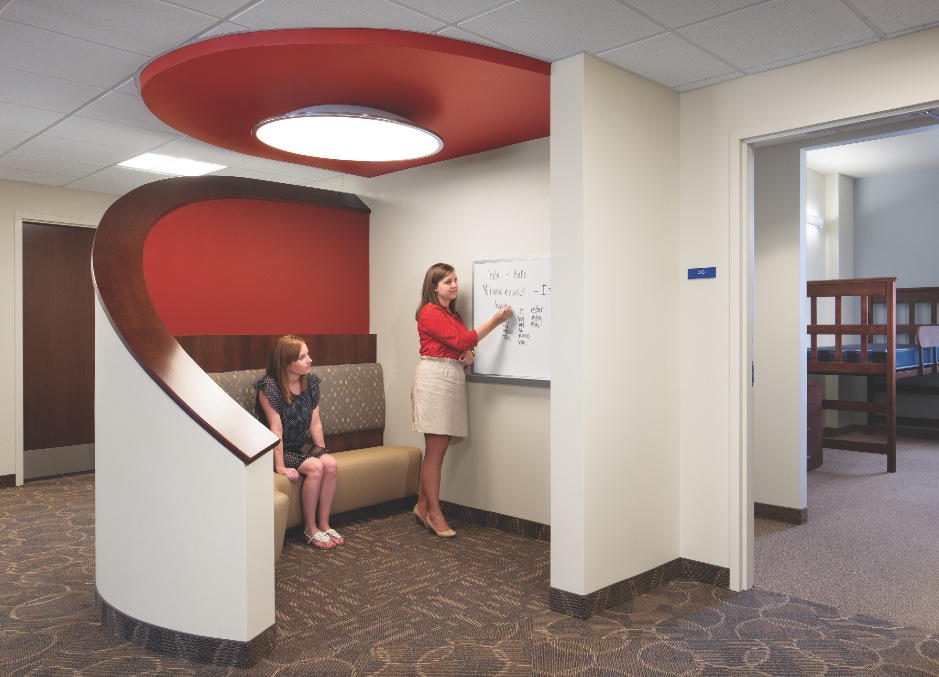
This trend is manifesting itself in all kinds of ways. About 18 months ago, KSQ Architects completed a project for Southern Methodist University in Dallas with 1,250 beds in five halls that also include a 500-seat dining common, faculty-in-residence apartments, classroom spaces, and an 800-car parking structure. David Short, AIA, KSQ’s Principal and Director, notes how this complex’s Georgian-style architecture harkens back to the college houses at universities like Oxford and Cambridge.
Another KSQ-designed student housing project under construction is a 750-bed residence hall at Stony Brook University in New York, which sits on top of a student union with academic space, a restaurant, and a Starbucks. “We had to make sure we had security and separate entrances for each of these spaces, yet kept the building open and inviting,” says Short.
In August 2014, the University of Maryland opened its six-story, 470-bed Prince Frederick Residence Hall, located east of its Robert H. Smith School of Business. Bob Keane, AIA, Managing Principal and Director of Higher Education for WDG Architecture, the hall’s designer, notes that a year earlier, Maryland, in partnership with Northrup Grumman, created its Advanced Cyber Security Experience for Students program. The lower levels of the residence hall serve as live-learn spaces for this program. The 186,000-sf hall includes seminar rooms, study rooms, and a 140-seat multipurpose room. Clark Construction was the GC on this $65.3 million project.
While purpose-built off-campus student housing typically doesn’t include classrooms, its common spaces are being used more frequently for private and group study, says Wes Rogers, President and CEO of Landmark Properties. The firm is one of the sector’s largest developers, builders, and property managers, focusing solely on off-campus housing.
Rogers says it’s imperative that its properties provide students with the best Internet service possible. Each of its buildings provides one gigabit per second bandwidth—25 megabits/second for each student.
“Over-the-top Internet is almost like hot water” in terms of what students expect, says Ronnie Macejewski, SVP of Development Services for Campus Advantage, which operates 45 student housing communities in 20 states.
2. Housing gets branded as lifestyle takes center stage.
Internet bandwidth is just one of the residential amenities that colleges use as selling points to lure students.
Temple University has featured Morgan Hall—a 1,275-bed residence hall that, at 24 stories, is the campus’s tallest structure—prominently in the school’s marketing, says Dan Kelley, FAIA, Senior Partner with MGA Partners Architects. His firm designed this three-building complex, which includes a large dining hall and a floor dedicated to student activities.
Schools also tout amenities that, over the years, have gotten more resort-like: infinity pools, huge fitness centers, golf simulators, rock-climbing walls, bike repair stations, and concierge desks.
Many schools view housing as an extension of their brand, says Michael Johnson, AIA, NCARB, President and Design Principal with Carrier Johnson + Culture. “On-campus housing has become far more amenitized, and there’s been a move toward higher densities, which affect the architecture,” he says. Johnson is seeing more on-campus housing that’s designed to “be as close as it can be” to market-rate apartments that compete for student renters. Branding plays a vital role.
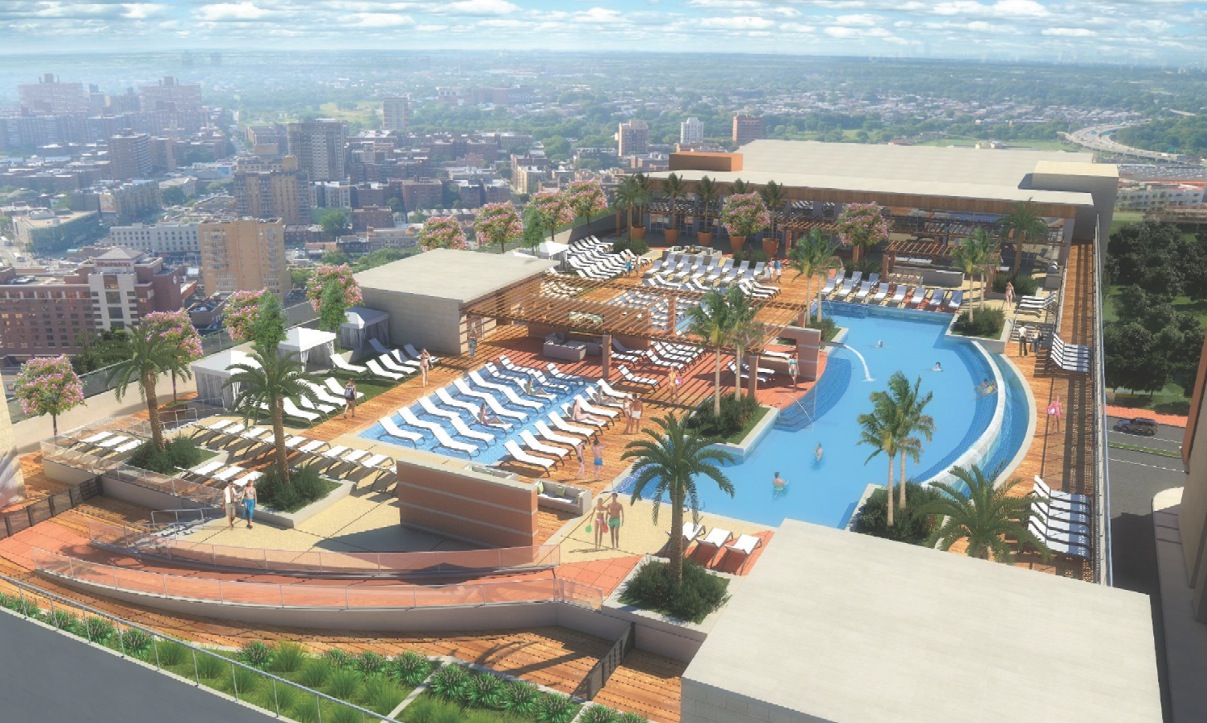 Student housing with over-the-top amenities has become an effective recruitment tool for a growing number of colleges. That trend has touched purpose-built off-campus housing such as The Standard of Gainesville, a 10-story, 1,200-bed facility being built near the campus of the University of Florida. Amenities will include 63,000 sf of retail space and a resort-style roof-deck pool. On the Building Team: Humphreys & Partners (architect), DEI (interior designer), Integrity Structural Corp. (SE), Vrettos Pappas Consulting Engineers (MEP), and Landmark Urban Construction Florida (GC). Photo: Courtesy Landmark Properties.
Student housing with over-the-top amenities has become an effective recruitment tool for a growing number of colleges. That trend has touched purpose-built off-campus housing such as The Standard of Gainesville, a 10-story, 1,200-bed facility being built near the campus of the University of Florida. Amenities will include 63,000 sf of retail space and a resort-style roof-deck pool. On the Building Team: Humphreys & Partners (architect), DEI (interior designer), Integrity Structural Corp. (SE), Vrettos Pappas Consulting Engineers (MEP), and Landmark Urban Construction Florida (GC). Photo: Courtesy Landmark Properties.
Carrier Johnson designed the 238,000-sf, five-building Village East at Torrey Pines complex on the campus of the University of California, San Diego. The development accommodates 807 students in 82 apartments in a 13-story tower and 60 apartments in four low rises, branded as Ecoflats. A ground-level walkway, called The Strand, runs through the buildings from the high-rise to The Bistro, an on-campus restaurant. The walkway includes glassed-in areas and gathering spaces “to create positive collision” among students, says Johnson. Even the complex’s centralized laundry room is branded: The Soap Bar.
Branding isn’t limited to on-campus housing, either. A KSQ-designed project called The VUE @ Liberty Mountain, completed last month near Liberty University, Tulsa, Okla., includes 676 beds, a 16,000-sf clubhouse, 24-hour fitness center, tanning beds, study rooms, a media center, two-tiered infinity pools, grilling stations and fire pits, an outdoor theater, and shuttle service to the campus that runs every 15 minutes.
Landmark uses a number of brands—including The Standard and The Retreat—for its properties.
3. Costs play a bigger role in what gets built.
These branded edifices paint a somewhat skewed picture of student housing as Shangri-La, when a lot of what’s out there is anything but. MGA Partners’ Kelley says he still sees a fair amount of basic “Comfort Inn-type” off-campus housing. Other sources point out that dorms built in the 1970s and 1980s comprise the bulk of many colleges’ on-campus housing stock.
The availability of capital dictates what gets built or renovated, where, and at what quality level. Developers have been adjusting their budgets to account for higher land costs to meet investors’ craving for higher-density off-campus student housing that’s as near to schools as possible.
Nearly all of Campus Advantage’s recent projects have been infill, says Michael Orsak, its SVP of Investments. That includes The Knox, which Campus Advantage developed with Pinecrest Partners. This 101-room, 382-bed community will serve students at the University of Tennessee’s main campus in Knoxville. The Knox’s two buildings, one five levels, the other six, are squeezed onto 1.6 acres of land.
Land cost and availability are factors that may have contributed to a 24% falloff in off-campus bed deliveries, to around 47,000, in 2015, according to the market research firm Axiometrics.
“With so much of what’s being built and developed in core urban areas closer to campuses, it’s harder to find land for these projects,” explains Taylor Gunn, Axiometrics’s Student Housing Analytics Leader.
Land, or lack thereof, is presenting a quandary for colleges and universities that want more students to live on campus. Also lacking, in many cases, is sufficient capital and the management expertise to operate an expanded housing portfolio.
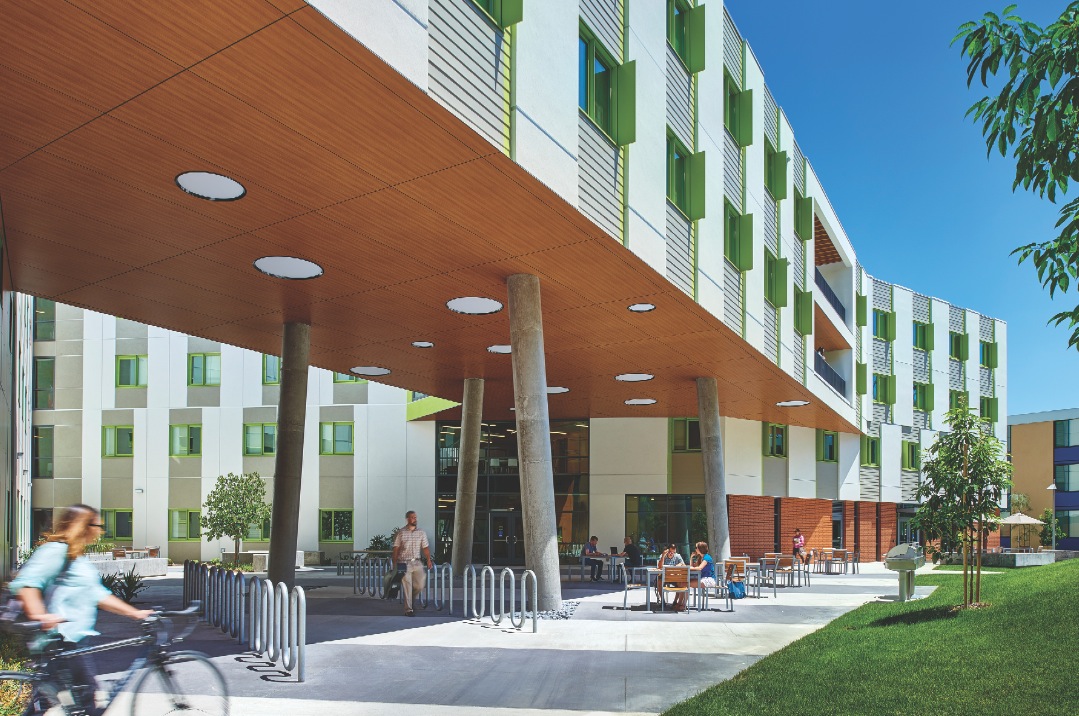 The four-story, 59,700-sf Blackstone Residence Hall at Biola University in La Mirada, Calif., maximizes housing for more than 300 students within a tight space that had been a parking lot. The outdoor walk-through (above) offers places where students can congregate. Amenities within the building include a multipurpose meeting room (below), 12 lounges, rooftop terrace, and outdoor amphitheater. Gensler was the design architect. Millie and Severson the GC. Photos: Courtesy of Ryan Gobuty, Courtesy of Gensler
The four-story, 59,700-sf Blackstone Residence Hall at Biola University in La Mirada, Calif., maximizes housing for more than 300 students within a tight space that had been a parking lot. The outdoor walk-through (above) offers places where students can congregate. Amenities within the building include a multipurpose meeting room (below), 12 lounges, rooftop terrace, and outdoor amphitheater. Gensler was the design architect. Millie and Severson the GC. Photos: Courtesy of Ryan Gobuty, Courtesy of Gensler

“A lot of colleges don’t have the bandwidth to build the housing they need,” says Jay Brotman, AIA, a Partner with Svigals+Partners. One solution is public-private partnerships with developers to finance, build, and manage on-campus student housing. Revenue sharing is often a component of these so-called P3 deals.
ACC has one of the sector’s more active P3 programs, with Arizona State University. In November, ACC broke ground on its sixth phase of the program, a residence hall for ASU’s engineering college. So far, ACC has invested $470 million on housing at ASU, where it will deliver a total of 6,700 beds without taxpayer money, says Bayless.
The $49.6 million Cornish Commons project was financed under a P3 with Capstone Development Partners and Harrison Street Real Estate Capital. Cornish College manages student services, and a division of Capstone manages the building. The ground lease reverts to the college when it expires in 2056.
“A lot of schools seem to want to get out of the housing-building business,” observes WDG’s Keane. However, P3s aren’t universally embraced, he explains. One reason: “You’re essentially building commercial housing within an institutional environment,” whose structures are generally meant to have much longer life spans.
4. Demographics accelerate demand.
Land and budgetary constraints notwithstanding, most market watchers foresee steady, sustained demand for student housing for at least the next five years.
In a recent interview with REIT.com, Randy Churchey, Chairman and CEO of EdR, a leading REIT and one of the largest developers, owners, and managers of student housing in the U.S., noted that about half of students at a typical university live off campus in single-family homes or other accommodations.
Last year, Inland American Real Estate Trust changed its name to InvenTrust Properties Corp. It had already spun off its lodging division, and would now focus on expanding its interests in two sectors: multi-tenant retail and student housing, the latter through its University House Communities business.
This synergy of retail and student housing is something other developers are exploiting. Last September, Landmark Properties started construction on The Standard of Gainesville (Fla.), a 10-story, 450-apartment, 1,200-bed student housing facility that will include 63,000 sf of retail space. Due for completion in November 2017, the complex will allocate at least 300 of its 1,200 parking garage spaces for retail customers.
In Springfield, Ill., developer Bluffstone LLC broke ground in December on the Villas Downtown Springfield, a four-story, 72-unit building for graduate students that will include 6,000 sf of retail and commercial space.
Jay Brotman, AIA, a Partner with Svigals+Partners, says that student housing his firm designs typically includes retail and casual-food components that allow these buildings and their residents to integrate into their larger communities.
However, adding retail can complicate a student housing project. In December, developer Core Campus found itself defending its proposal for a mixed-use, 670-bed building called The Hub on Mike’s Pike on 2.5 acres in Flagstaff, Ariz. Local residents were concerned about increased traffic and on-street parking that this development would generate. Similar concerns have led at least one metro, Columbia, Mo., whose downtown has seen a student housing boom in the past few years, to consider overhauling its zoning laws to modulate future development.
Retail isn’t always an ideal match for student housing, say some experts. Several of Campus Advantage’s 45 properties include retail, “and it’s a full-time job keeping those spaces full, especially when you’re talking about 4,000 sf or less,” says Ronnie Macejewski, CA’s SVP of Development Services. He also isn’t sure how profitable retail is when mixed with student housing. “It might be more of a loss leader.” (Photo: Carrier Johnson + Culture).
“A lot of these students are migrating to purpose-built student housing, and we think we can grow our share of the market much larger,” he said.
Landmark currently has a $3 billion pipeline of student housing projects that it plans to build within the next three years, with more than $1 billion already in the works.
This sector will be a magnet for investors if rents and property values continue to appreciate, which is likely. Bayless notes that in the 11 years since ACC became a REIT, it has never experienced a year of negative rent growth. In October, Harrison Street Real Estate Capital agreed to pay $1.9 billion for the REIT Campus Crest Communities, a REIT that has ownership interest in 79 student-housing properties with more than 42,000 beds.
The student housing market should keep growing “as long as [students’] parents don’t run out of money,” quips Greg Faulkner, AIA, NCARB, President of Humphreys & Partners Architects, whose clientele includes 18 of the top 25 student housing owners. He says that more than 95% of the projects Humphreys has worked on recently have been preleased before construction is completed. “That would have been unheard of five or 10 years ago,” he says.
Faulkner points out that colleges have little choice but to up their student housing game if they want to compete for the nearly 70% of graduating high school students who enroll in college. More than a million foreign students attend college in the U.S., and their numbers are rising.
In light of encouraging market and demographic patterns, universities are leaving no stone unturned for expansion opportunities, even in areas that previously seemed inhospitable to student housing.
WDG is involved in a project called Terrapin Row, located on what had been a sketchy edge of the University of Maryland’s College Park campus. The site was once known for its “Knox Boxes,” 25 ramshackle two-story duplex apartments dating back to the 1950s that had multiple owners.
The semi-custom homebuilder Toll Brothers, through its Campus Living subsidiary, is redeveloping this 6.2-acre site into a mixed-use, 626,340-sf student housing community featuring four residential halls with 418 units and 1,515 beds, 11,900 sf of retail, and a 171,220-sf, seven-level parking structure with 507 spaces. Terrapin Row opens this summer.
The Cadence, a 294,000-sf, dual-building, off-campus development in Tucson, Ariz., “started out as a parking lot in a neighborhood that wasn’t all that desirable,” says Ankrom Moisan’s Jones, whose client is Capstone. His firm’s design “definitely has a loft feel to it.” The 289-bed first building is five floors over podium, with a concierge desk, study center, pool, and gym. The 167-bed second building includes three residence floors and ground-floor retail over existing parking.
Stretching the concept of student housing, Svigals+Partners has designed a building near Yale University in New Haven, Conn., that will offer 112 furnished micro (400 sf) studios for temporary rental by international students, visiting professors, and other guests. “I can’t imagine other universities don’t have this same need,” says Brotman.
To figure out where student housing is headed, KSQ and the consulting firm Biddison Hier are conducting a yearlong research project. They’ve been talking with the Association of College and University Housing Officers about polling its members, and have identified 20 colleges they plan to visit in the coming months.
Last November, the team trekked to North Carolina, where it met with Dean- and VP-level officials at several prominent colleges. What emerged from this sojourn, says Monica Roberts, KSQ’s Director of Communications and Strategic Planning, were ideas about how housing can play a bigger role in student development.
One of the colleges she toured was Elon University, which had recently converted an underutilized lounge in one of its residence halls into a maker space, with laser cutters, 3D printers, and tech gizmos for use by students, entrepreneurs, and hobbyists. This is a sign of things to come in the student housing sector.
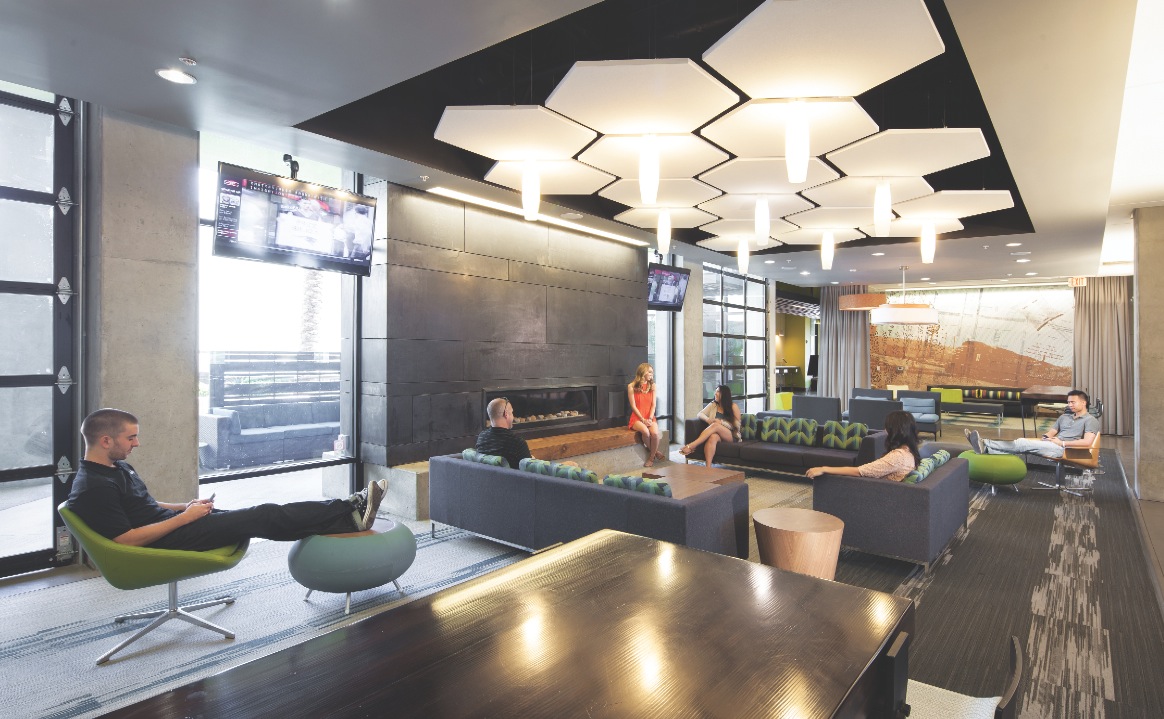 The Cadence, an urban infill project in Tucson, Ariz., is the University of Arizona’s only affiliated off-campus student housing complex. Its 15,000 sf of indoor and outdoor amenities include The Clubhouse (pictured), where students can get out of their rooms to relax and mingle. The Building Team: Ankrom Moisan Architects (design architect), PK Associates (SE), Peterson Associates (MEP), Norris Design (landscape), and Summit–DCK Worldwide (GC). Photo: Courtesy Ankrom Moisan Architects.
The Cadence, an urban infill project in Tucson, Ariz., is the University of Arizona’s only affiliated off-campus student housing complex. Its 15,000 sf of indoor and outdoor amenities include The Clubhouse (pictured), where students can get out of their rooms to relax and mingle. The Building Team: Ankrom Moisan Architects (design architect), PK Associates (SE), Peterson Associates (MEP), Norris Design (landscape), and Summit–DCK Worldwide (GC). Photo: Courtesy Ankrom Moisan Architects.
Related Stories
| Jan 21, 2011
Nothing dinky about these residences for Golden Gophers
The Sydney Hall Student Apartments combines 125 student residences with 15,000 sf of retail space in the University of Minnesota’s historic Dinkytown neighborhood, in Minneapolis.
| Jan 21, 2011
Virginia community college completes LEED Silver science building
The new 60,000-sf science building at John Tyler Community College in Midlothian, Va., just earned LEED Silver, the first facility in the Commonwealth’s community college system to earn this recognition. The facility, designed by Burt Hill with Gilbane Building Co. as construction manager, houses an entire floor of laboratory classrooms, plus a new library, student lounge, and bookstore.
| Jan 20, 2011
Community college to prepare next-gen Homeland Security personnel
The College of DuPage, Glen Ellyn, Ill., began work on the Homeland Security Education Center, which will prepare future emergency personnel to tackle terrorist attacks and disasters. The $25 million, 61,100-sf building’s centerpiece will be an immersive interior street lab for urban response simulations.
| Jan 19, 2011
Biomedical research center in Texas to foster scientific collaboration
The new Health and Biomedical Sciences Center at the University of Houston will facilitate interaction between scientists in a 167,000-sf, six-story research facility. The center will bring together researchers from many of the school’s departments to collaborate on interdisciplinary projects. The facility also will feature an ambulatory surgery center for the College of Optometry, the first of its kind for an optometry school. Boston-based firms Shepley Bulfinch and Bailey Architects designed the project.
| Dec 28, 2010
Project of the Week: Community college for next-gen Homeland Security personnel
The College of DuPage, Glen Ellyn, Ill., began work on the Homeland Security Education Center, which will prepare future emergency personnel to tackle terrorist attacks and disasters. The $25 million, 61,100-sf building’s centerpiece will be an immersive interior street lab for urban response simulations.
| Dec 17, 2010
Sam Houston State arts programs expand into new performance center
Theater, music, and dance programs at Sam Houston State University have a new venue in the 101,945-sf, $38.5 million James and Nancy Gaertner Performing Arts Center. WHR Architects, Houston, designed the new center to connect two existing buildings at the Huntsville, Texas, campus.
| Dec 17, 2010
New engineering building goes for net-zero energy
A new $90 million, 250,000-sf classroom and laboratory facility with a 450-seat auditorium for the College of Electrical and Computer Engineering at the University of Illinois at Urbana/Champaign is aiming for LEED Platinum.
| Dec 17, 2010
How to Win More University Projects
University architects representing four prominent institutions of higher learning tell how your firm can get the inside track on major projects.
| Nov 23, 2010
The George W. Bush Presidential Center, which will house the former president’s library
The George W. Bush Presidential Center, which will house the former president’s library and museum, plus the Bush Institute, is aiming for LEED Platinum. The 226,565-sf center, located at Southern Methodist University, in Dallas, was designed by architect Robert A.M. Stern and landscape architect Michael Van Valkenburgh.
| Nov 9, 2010
Just how green is that college campus?
The College Sustainability Report Card 2011 evaluated colleges and universities in the U.S. and Canada with the 300 largest endowments—plus 22 others that asked to be included in the GreenReportCard.org study—on nine categories, including climate change, energy use, green building, and investment priorities. More than half (56%) earned a B or better, but 6% got a D. Can you guess which is the greenest of these: UC San Diego, Dickinson College, University of Calgary, and Dartmouth? Hint: The Red Devil has turned green.



